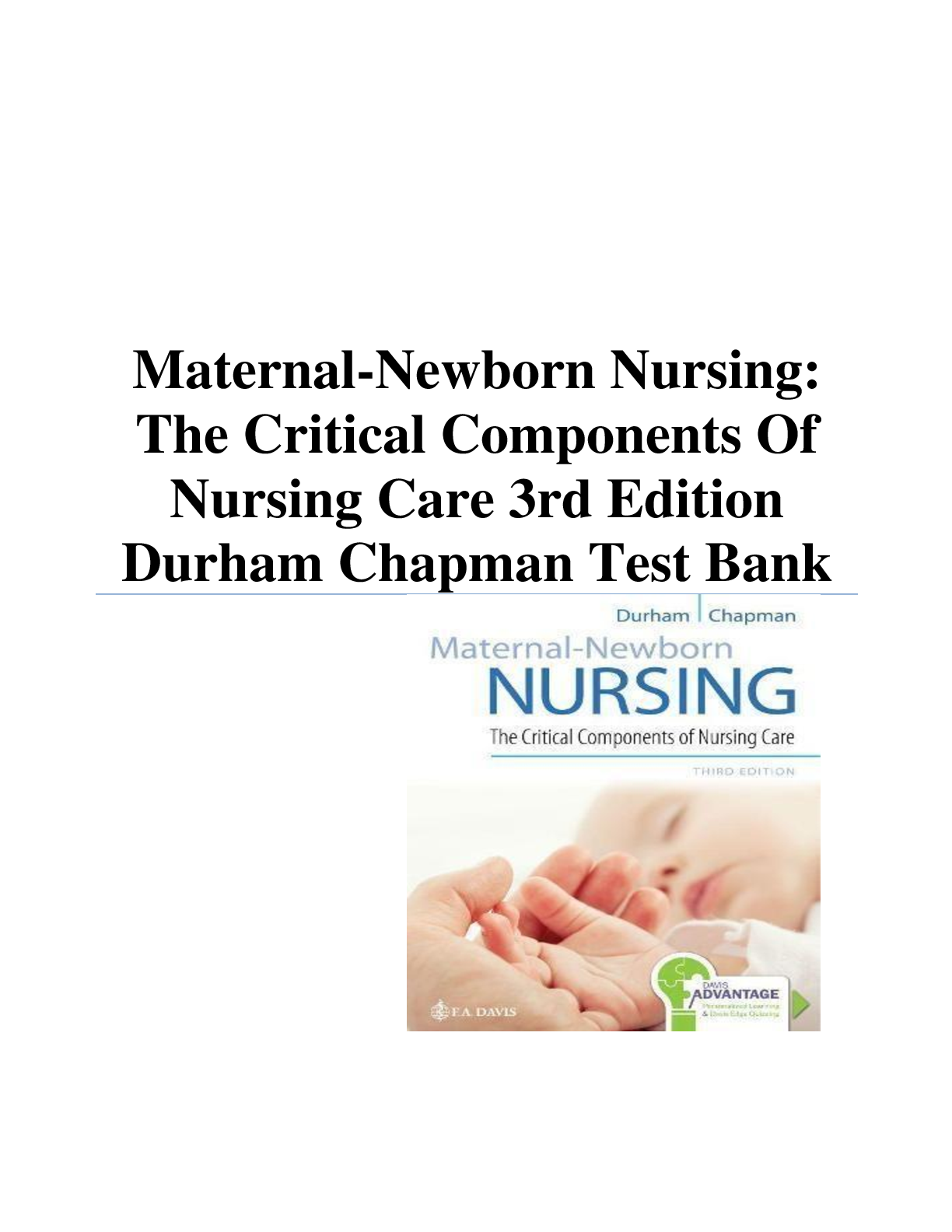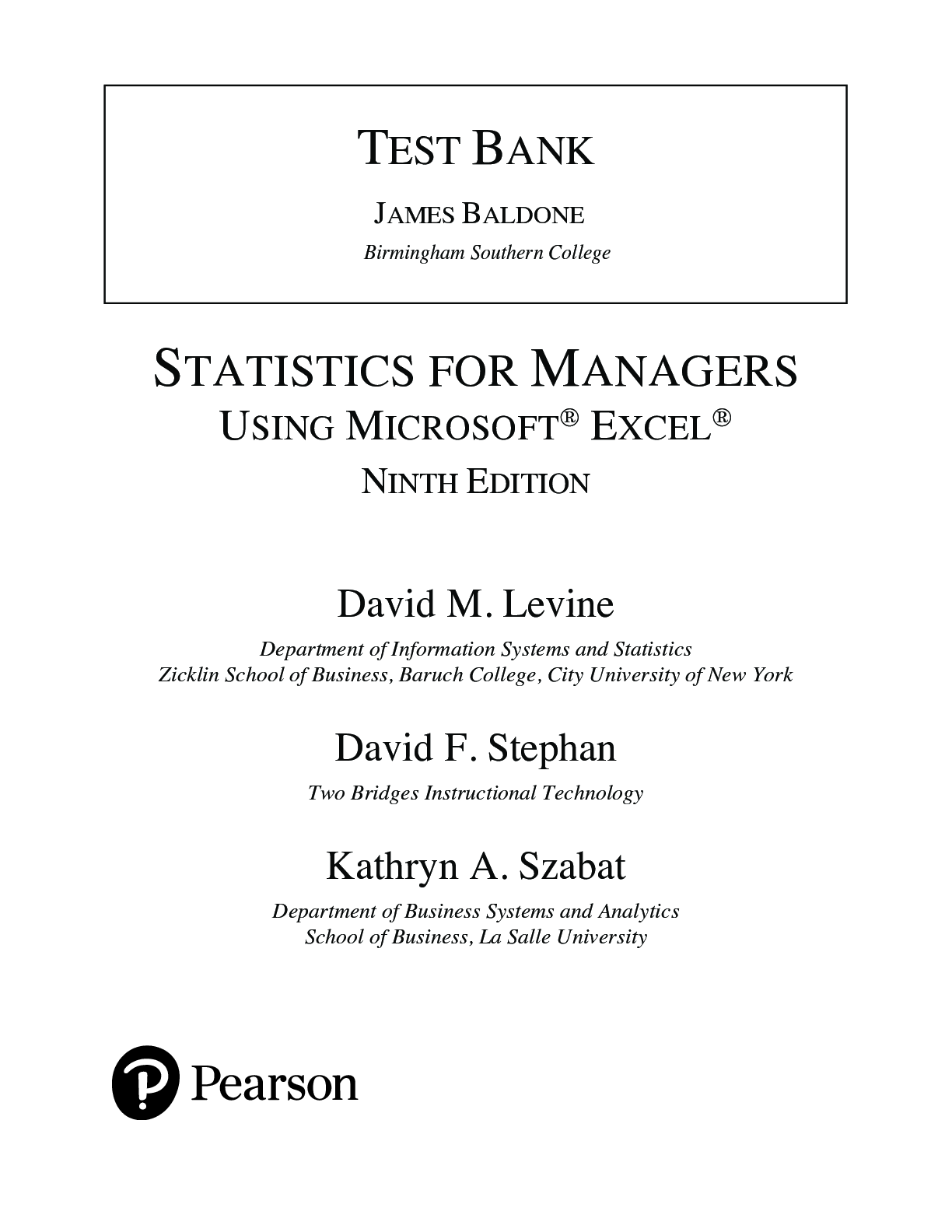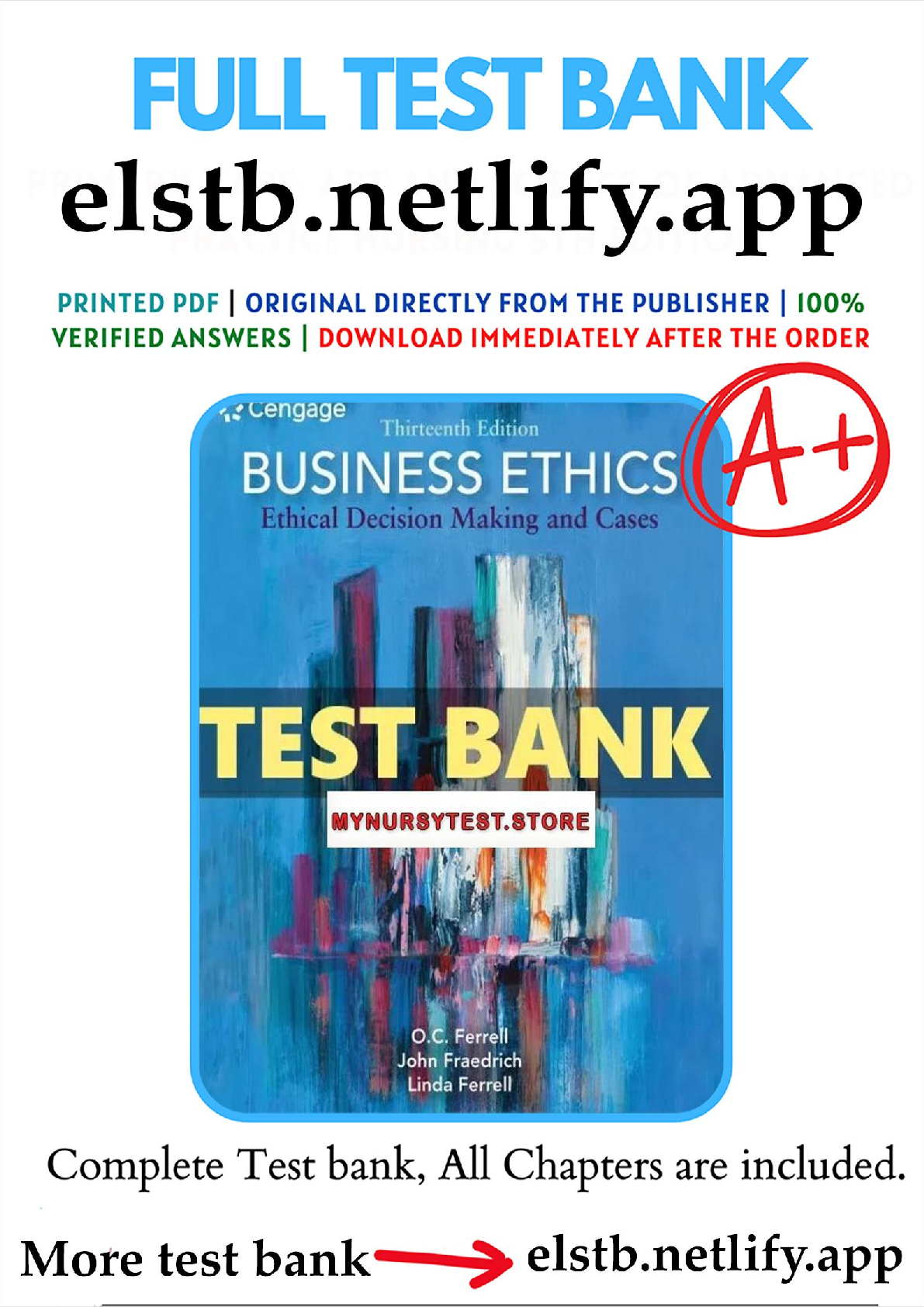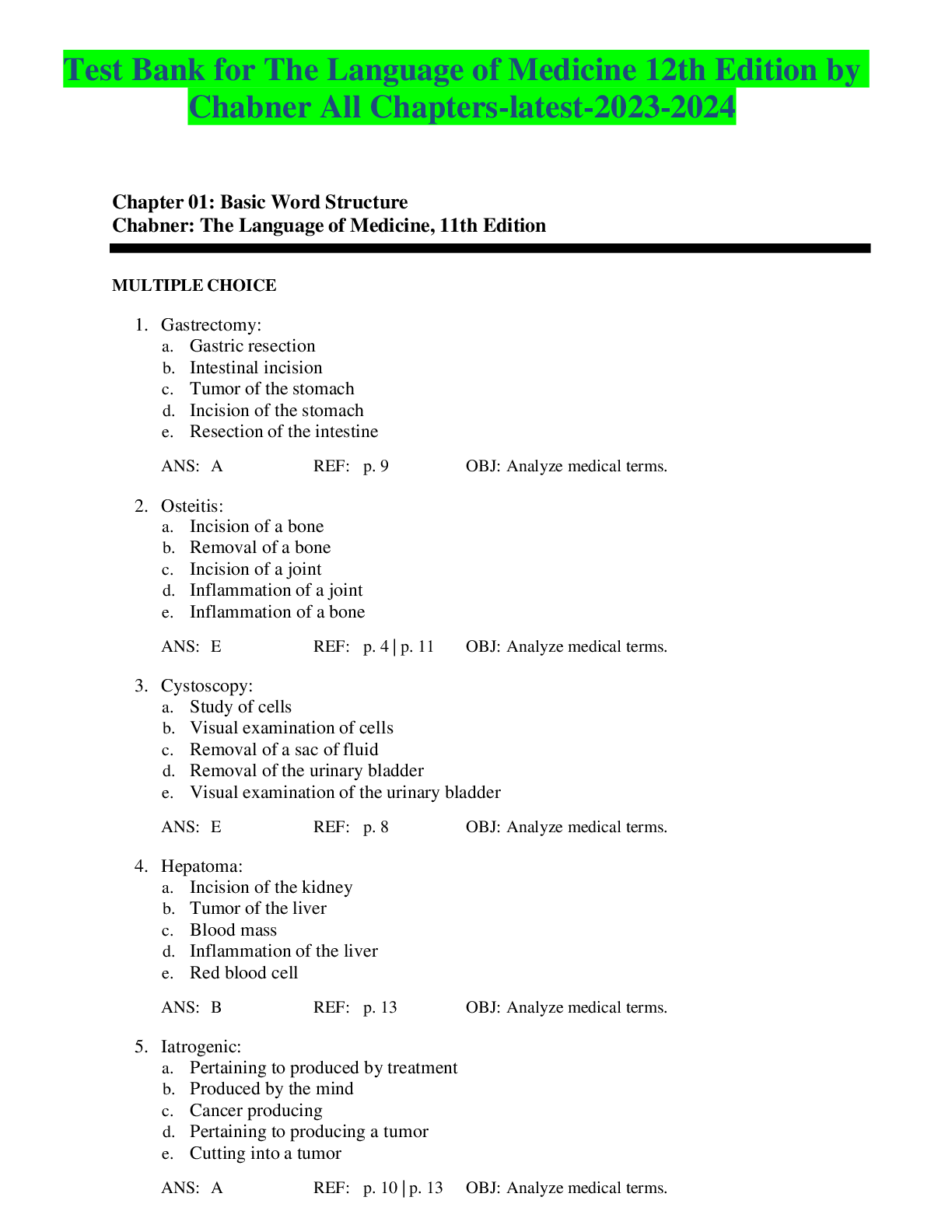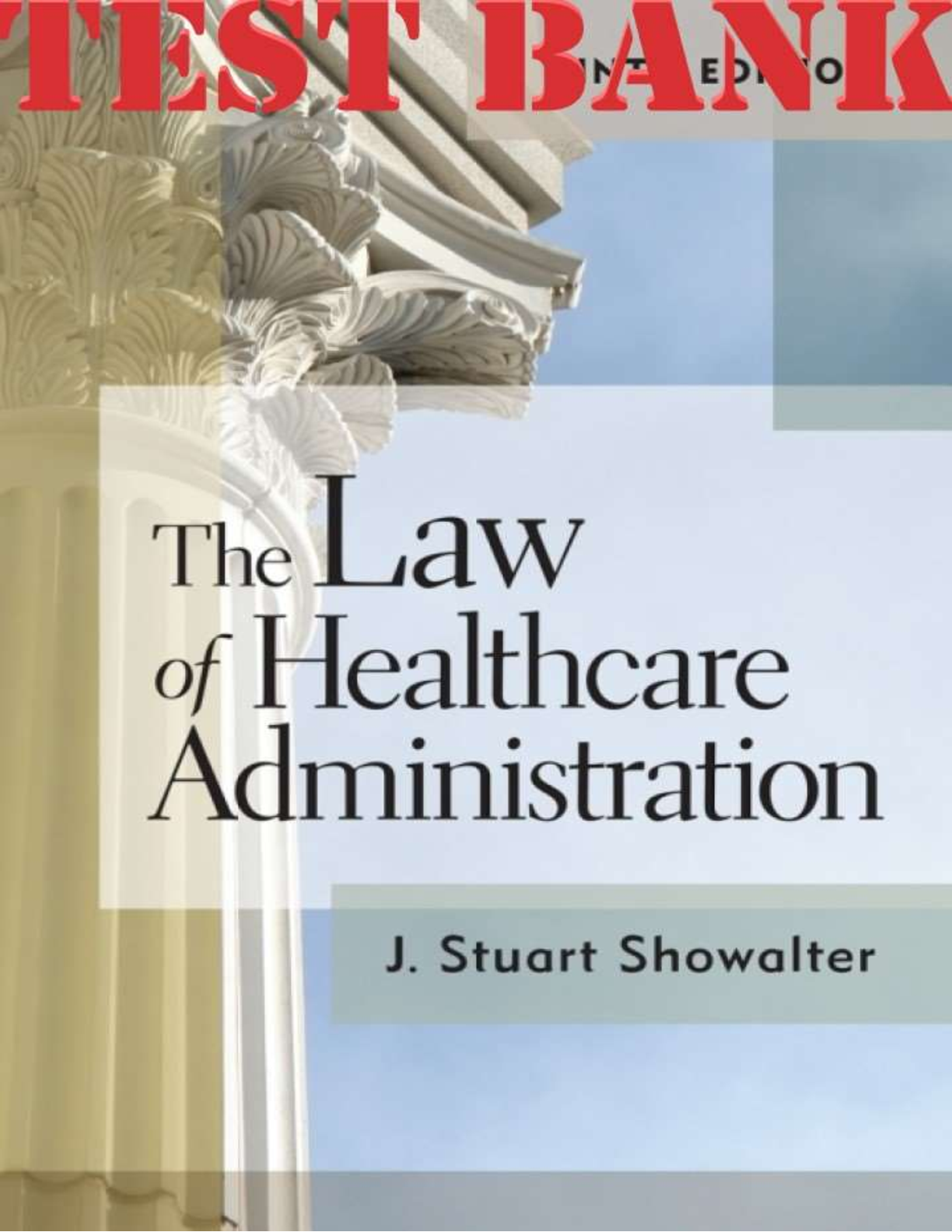Health Care > TEST BANKS > Complete Test Bank for Rau’s Respiratory Care Pharmacology 9th Edition by Douglas S. Gardenhire! R (All)
Complete Test Bank for Rau’s Respiratory Care Pharmacology 9th Edition by Douglas S. Gardenhire! RATED A+
Document Content and Description Below
Complete Test Bank for Rau’s Respiratory Care Pharmacology 9th Edition by Douglas S. Gardenhire! RATED A+What is the name of the receptor sites that are located in the peripheral vasculature, the he... art, bronchial muscle, and bronchial blood vessels? a. Beta 2 receptors c. Alpha receptors b. Gamma receptors d. Beta 1 receptors ANS: C Alpha receptors are located in the peripheral vasculature, the heart, bronchial muscle, and bronchial blood vessels. PTS: 1 2. Which receptor site results in tachycardia, an increased potential for arrhythmias, and an increased cardiac output? a. Beta 1 receptor c. Alpha receptor b. Beta 2 receptor d. Delta receptor ANS: A Stimulation of the beta-1 receptors results in tachycardia, an increased potential for arrhythmias, and an increased cardiac output. In administering drugs to the pulmonary system, stimulation of the beta-1 sites is not desired. However, most respiratory pharmacologic agents have some beta-1 stimulatory effect. PTS: 1 3. Stimulation of the beta 2 receptors causes a. peripheral vasoconstriction and mild bronchoconstriction in the lungs. b. tachycardia, an increased potential for arrhythmias, and an increased cardiac output. c. bronchodilation. d. peripheral vasodilation, bradycardia, and decreased cardiac output. ANS: C Stimulation of the beta-2 receptors in the lungs causes bronchodilation. PTS: 1 4. Acetylcholine stimulates a. the Vagus nerve. b. the adrenergic receptors. c. the sympathetic nervous system. d. the cholinergic receptors. ANS: D Acetylcholine stimulates the cholinergic receptors. PTS: 1 5. What immunoglobulin antibody sensitizes the mast cell? a. Leukotrienes c. Histamine b. IgE d. Prostaglandins ANS: B The IgE (reagin) antibodies sensitize the mast cell. Repeated exposure to the antigen causes the degranulation of the mast cell. PTS: 1 6. Which of the following is caused by histamine release from the mast cells? I. Bronchodilation II. Increased bronchial gland secretion III. Increased amount of mucus present in the airways a. I and II only c. III only b. II and III only d. I, II, III ANS: B Histamine is also a potent bronchoconstrictor. In addition to its bronchoconstrictive activity, histamine II) increases bronchial gland secretion, causing III) an increase in the amount of mucus present in the airways. Histamine may also have an effect on vascular permeability similar to the effect ofSRS-A. PTS: 1 7. A sympathomimetic drug would cause a. bronchodilation. c. Histamine release. b. bronchoconstriction. d. Vagus nerve stimulation. ANS: A A sympathomimetic drug would cause bronchodilation. Sympathomimetic agents are the drugs most commonly used to reverse bronchospasm. PTS: 1 8. Stimulation of the sympathetic nervous system causes a. vascular permeability. c. bronchodilation. b. decreased blood pressure. d. bronchoconstriction. ANS: C Sympathetic nervous system stimulation causes bronchodilation. PTS: 1 9. Which of the following would NOT cause a bronchospasm or bronchoconstriction? a. Leukotrienes c. Histamine b. Beta 1 receptors d. Prostaglandins ANS: B Beta-1 receptors would not cause a bronchospasm or bronchoconstriction. Leukotrienes are one of many chemical mediators released by the mast cells. Leukotrienes cause a direct, strong bronchoconstriction. Histamine is also a potent bronchoconstrictor. Prostaglandins cause a strong bronchospasm, especially in asthmatic patients. PTS: 1 10. Place the following intracellular events of the Beta 2 receptor stimulation in order. I. Phosphodiesterase breaks down cyclic 3’, 5’-AMP into 5’-AMP II. Adenylate cyclase combines with magnesium and ATP to form cyclic 3’,5’-AMP III. Cyclic 3’,5’-AMP results in bronchial smooth muscle relaxation IV.Beta-2 stimulation causes the formation of adenylate cyclase a. I, II, III, IV c. IV, II, III, I b. III, IV, I, II d. IV, III, II, I ANS: C The following order is correct: IV) Beta-2 stimulation causes the formation of adenylate cyclase. II) Adenylate cyclase combines with magnesium and ATP (adenosine triphosphate) to form cyclic 3’,5’- AMP (adenosine monophosphate). III) Cyclic 3’,5’-AMP results in bronchial smooth muscle relaxation and hence bronchodilation. Cyclic 3’,5’-AMP is not a long-lived agent. It is readily broken down by another enzyme present in the lungs called phosphodiesterase. I) Phosphodiesterase breaks 3’,5’-AMP down into 5’-AMP, which no longer causes bronchodilation. PTS: 1 11. Release of acetylcholine will cause a. bronchodilation. c. stimulation of cyclic 3’5’ AMP. b. Mast cell stabilization. d. bronchospasm. ANS: D Cholinergic receptors are cells that respond when stimulated by acetylcholine. Cholinergic receptors cause profound bronchospasm in the lungs when stimulated. Cholinergic receptors are found in the parasympathetic nervous system. PTS: 1 12. Which of the following is NOT an example of a sympathomimetic drug? a. Salmeterol Xinafoate c. Pirbuterol Acetate b. Formoterol fumarate d. Atropine Sulfate ANS: D Atropine sulfate is a anti-cholinergic bronchodilator. Salmeterol, formoterol, and pirbuterol are all sympathomimetic bronchodilators. PTS: 1 13. Which of the following sympathomimetic drugs are intended for maintenance therapy only? I. Levalbuterol II. Salmeterol III. Formoterol IV.Pirbuterol a. II, III, and IV c. II and III b. I and IV d. I, II, III, and IV ANS: C II) Salmeterol and III) Formoterol are intended for maintenance therapy only. PTS: 1 14. A pediatric patient is admitted to the emergency department from a physician’s office with the suspected diagnosis of croup. An inspiratory stridor is heard. Which aerosolized sympathomimetic would you recommend to decrease the stridor? a. Racemic epinephrine c. Levalbuterol b. Albuterol d. Isoproterenol ANS: A Racemic epinephrine (Vaponephrine) is a sympathomimetic drug. However, its alpha effects are strong and it is commonly used to relieve croup and epiglottitis symptoms in children. PTS: 1 15. Aminophylline causes bronchodilation by a. stimulating the production of cyclic 3’5’ AMP. b. blocking the parasympathetic nervous system. c. inhibiting the enzyme phosphodiesterase. d. causing Mast cell degranulation. ANS: C Aminophylline is a phosphodiesterase inhibitor. It is an example of drugs in the xanthine group. Common phosphodiesterase drugs are found in the methylxanthine group. Cyclic 3’,5’-AMP is broken down into 5’-AMP by the enzyme phosphodiesterase. If the action of phosphodiesterase can be blocked or inhibited, more 3’,5’-AMP will remain in the lungs, resulting in better bronchodilation. Phosphodiesterase inhibitors act in this way. PTS: 1 16. Inhibition of the sympathetic nervous system would cause a. bronchoconstriction. b. stridor. c. bronchodilation. d. relaxation of the bronchial smooth muscle. ANS: A If the sympathetic nervous system is inhibited, it would cause bronchoconstriction. PTS: 1 17. Which of the following drugs cause bronchodilation by inhibiting the effects of the parasympathetic nervous system? I. Atropine sulfate II. Ipratropium bromide III. Tiotropium bromide IV.Terbutaline sulfate a. I and IV c. I, II, III b. II and III d. IV only ANS: C I) Atropine, II) ipratropium, and III) tiotropium are all examples of antocholinergic bronchodilators (bronchodilators that work by blocking the parasympathetic nervous system). Anticholinergic drugs block the cholinergic receptor sites, preventing that route of bronchospasm. PTS: 1 18. Corticosteroids: a. cause brondilation directly. b. reduce inflammation. c. stabilize Mast cells. d. should always be administered with a bronchodilator. ANS: B Corticosteroids are widely used in the management of the inflammatory process associated with asthma, reactive airways disease, and other pulmonary disorders. PTS: 1 19. A patient is ready to be discharged to her home. At home the patient has a compressor and a small volume nebulizer. Which of the following corticosteroids is in solution and is intended to be administered via a small volume nebulizer? a. Prednisone c. Budesonide b. Dexamethasone d. Triamcinolone ANS: C Budesonide (Pulmocort) is available as both an inhalant solution (0.25 mg/ mL once daily) and a dry powder formulation (200 mcg/dose twice daily). In aerosol form, this anti-inflammatory medication targets the lungs specifically with fewer side effects. PTS: 1 20. Salmeterol and Fluticasone are combined into a DPI preparation. What is the purpose of these two drugs combined? a. Maintenance bronchodilation and Mast cell stabilization b. Mucolysis and anti-inflammation c. Bronchodilation by stimulating the sympathetic nervous system and inhibiting the parasympathetic nervous system d. Maintenance bronchodilation and anti-inflammation ANS: D Fluticasone propionate (Flovent) and salmeterol (Serevent) have been combined into a DPI preparation containing 100 mcg of fluticasone propionate and 50 mcg of salmeterol. By taking both drugs together, the long-term effects of both d) maintenance bronchodilation and anti-inflamation can be achieved. PTS: 1 21. Which of the following drugs stabilize mast cells? a. Ipratropium c. Albuterol b. Cromolyn sodium d. Fluticasone ANS: B Cromolyn sodium is a prophylactic agent; it prevents mast cell degranulation. A patient must use the drug on a regular basis to prevent acute bronchospastic episodes. PTS: 1 22. Montelukast, Zarfirlukast, and Zileuton are all used as maintenance therapy for asthma. How do they work? a. They stabilize the Mast cells. b. The cause bronchodilation. c. They are mucolytics. d. They are leukotriene inhibitors. ANS: D Montelukast (Singulair), Zarfirlukast (Accolate), and Zileuton (Zyflo) are leukotriene inhibitors used for maintenance therapy in asthma. PTS: 1 23. One of the side effects of Acetylcysteine is bronchospasm. How can this side effect be avoided? a. By giving Acetylcysteine with a bronchodilator. b. By giving the patient a corticosteroid after the treatment. c. By administering half of the therapy, allowing the patient to rest, then finishing the therapy. d. By simultaneous use of sodium bicarbonate. ANS: A Usually, acetylcysteine is given with a bronchodilator to prevent the bronchospastic side effect. PTS: 1 24. Which of the following is a frequently nebulized antibiotic for patients with cystic fibrosis? a. Pentamidine c. Sodium bicarbonate b. Ribvirin d. Tobramycin ANS: D Tobramycin (TOBI) and gentamicin are sometimes aerosolized for use in patients with cystic fibrosis and have shown some efficacy in treatment of the recurrent infections these patients experience. PTS: 1 25. MDI spacer devices are used in conjunction with MDIs to: a. serve as a baffle, removing smaller particles from suspension. b. enhance the effectiveness of aerosol deposition and improve medication delivery. c. act as a reservoir that helps to decrease the evaporation of the MDI propellant. d. a, b, and c. ANS: B MDI spacer devices are used in conjunction with MDIs and enhance the effectiveness of aerosol deposition and improve medication delivery PTS: 1 ESSAY 1. An aerosol drug is ordered on a patient in MDI form. The propellant causes a reflex bronchospasm in the patient. What can be done? ANS: The drug could be delivered to the patient in other forms such as DPI form or in solution by a small volume nebulizer. A spacer could be used to allow for partial evaporation of the propellant from the MDI. If the drug is available in pill form or oral solution it could be delivered via mouth. PTS: 1 2. A small volume nebulizer is ordered for a patient on a mechanical ventilator. To prevent condensation and secretions from draining into the nebulizer and contaminating it, what could be done? ANS: A heated wire circuit should decrease the amount of condensation in the ventilator tubing and therefore the amount of solution that could get into the nebulizer cup. Position the nebulizeer so that the upper end of the reservoir would be higher than the ventilator tubing. Use barriers (one-way valve) between the nebulizer cup and the and the ventilator circuit. It could also be suggested to the physician that an MDI be used instead of the SVN and the device could be removed immediately after the therapy. PTS: 1 3. After delivery of an adrenergic bronchodilator with a small volume nebulizer, a patient complains of “shakiness” and feeling “nervous”. He notes palpitations and his heart feels like it is racing. What is happening and how could these problems be corrected? ANS: The patient is having adverse side effects from the bronchodilator. The patient’s bronchodilator could be given with more diluting solution, the amount of medication could be decreased, or the patient could be given another bronchodilator with fewer side effects. PTS: 1 Chapter 01: Introduction to Respiratory Care Pharmacology Gardenhire: Rau’s Respiratory Care Pharmacology, 9th Edition The superscription directs the pharmacist to take the drug listed and prepare the medication; the inscription lists the name and quantity of the drug being prescribed; the subscription provides directions to the pharmacist for preparing the medication; and the transcription, or signature, is the information the pharmacist writes on the label as instructions to the patient. REF: p. 7 A generic substitution allows any brand of a drug to be given, but the pharmacist may not change a drug formulation without specific permission from the prescribing physician. A physician can indicate to the pharmacist that generic substitution is permitted in the filling of the prescription. In such a case, the pharmacist may provide any manufacturer’s version of the prescribed drug, rather than a specific brand. However, the pharmacist may not change the strength of a drug without specific permission from the prescribing physician. REF: p. 8 Pharmacogenetics is the study of the interrelationship of genetic differences and drug effects. Pharmacology is the study of drugs (chemicals), including their origin, properties, and interactions with living organisms. Therapeutics is the art of treating disease with drugs. Toxicology is the study of toxic substances and their pharmacologic actions, including antidotes and poison control. REF: p. 3 The chemical name indicates the drug’s chemical structure. The generic name is assigned by the United States Adopted Name Council and is usually based loosely on the drug’s chemical structure. The official name is the name given to the generic name once a drug becomes fully approved for general use and is admitted to the United States Pharmacopeia–National Formulary. The trade name is the brand, or proprietary, name given by a particular manufacturer. For example, the generic drug albuterol is currently marketed by ScheringPlough as Proventil® and by GlaxoSmithKline as Ventolin®. REF: p. 5 Because the PDR is prepared by drug manufacturers themselves, it may be lacking in objectivity. Basic & Clinical Pharmacology covers only general pharmacologic principles and drug classes. Goodman & Gilman’s The Pharmacological Basis of Therapeutics covers only general pharmacologic principles and drug classes. The USP-NF is a book of standards containing information about medications, dietary supplements, and medical devices. The U.S. Food and Drug Administration (FDA) considers this book the official standard for drugs marketed in the United States. REF: p. 5 Drugs may be obtained from plants (e.g., digitalis), animals (e.g., insulin), and minerals (e.g., magnesium sulfate). REF: p. 5 The United States Adopted Name (USAN) Council is responsible for assigning a generic name to a chemical that appears to have therapeutic use. The U.S. Food and Drug Administration (FDA) is responsible for the process of approving drugs for clinical use. The process by which a chemical moves from the status of a promising potential drug to one fully approved by the FDA for general clinical use is, on average, long, costly, and complex. Cost estimates vary, but in the 1980s it took an average of 13 to 15 years from chemical synthesis to marketing approval by the FDA, with a cost of $350 million in the United States. The USPNF is a book of standards for medications, dietary supplements, and medical devices. The PDR is a source of drug information prepared by drug manufacturers. REF: p. 4 An orphan drug is a drug or biologic product for the diagnosis or treatment of a rare disease. Rare is defined as a disease that affects less than 200,000 persons in the United States. Alternatively, a drug may be designated as an orphan if used for a disease that affects more than 200,000 persons in the United States but for which there is no reasonable expectation of recovering the cost of drug development. Orphan drugs are often quite expensive to produce because they have a limited market in which to recoup the initial investment. REF: p. 6 | p. 7 A prescription may be written by a physician, osteopath, dentist, and veterinarian and some other practitioners but not by chiropractors. [Show More]
Last updated: 3 months ago
Preview 3 out of 5 pages

Loading document previews ...
Buy this document to get the full access instantly
Instant Download Access after purchase
Buy NowInstant download
We Accept:

Reviews( 0 )
$13.00
Can't find what you want? Try our AI powered Search
Document information
Connected school, study & course
About the document
Uploaded On
May 09, 2025
Number of pages
5
Written in
Additional information
This document has been written for:
Uploaded
May 09, 2025
Downloads
0
Views
47



